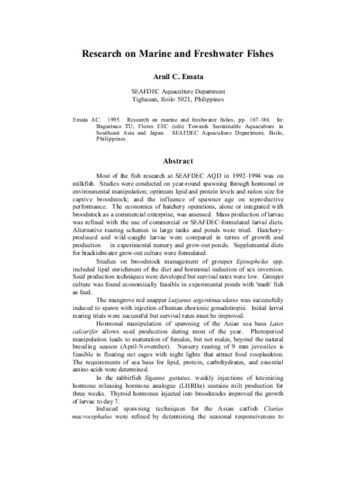Improved larval survival at metamorphosis of Asian seabass (Lates calcarifer) using ω3-HUFA-enriched live food
- Global styles
- MLA
- Vancouver
- Elsevier - Harvard
- APA
- Help

ดู/เปิด
วันที่
1990Page views
3,121ASFA keyword
AGROVOC keyword
Taxonomic term
เมตาดาต้า
แสดงระเบียนรายการเต็มCited times in Scopus
- Citations
- CrossRef - Citation Indexes: 53
- Policy Citation - Policy Citations: 2
- Scopus - Citation Indexes: 73
- Captures
- Mendeley - Readers: 37
Share
นามธรรม
Asian seabass (Lates calcarifer) larvae were fed Brachionus cultured on Chlorella and, as soon as ingestin was possible, different types of Artemia, i.e., nauplii of the San Francisco Bay (SFB) strain, Great Salt Lake (GSL) strain or GSL nauplii that had been bioencapsulated with an emulsion containing high levels of the ω3-HUFAs (highly unsaturated fatty acids) 20:5 and 22:6. San Francisco Bay Artemia with a good natural fatty acid profile and small body size could be offered earlier than the larger but HUFA-poor Great Salt Lake strain. The poor nutritional quality of the latter, however, could be corrected by enriching the nauplii with an ω3-HUFA emulsion for 24 h, after which time high levels of the ω3-HUFAs 20:5 and 22:6 were obtained. When the Artemia diet offered before metamorphosis included natural or supplemented essential fatty acids, no significant differences in dry weight, length or survival of the fish were noticed, as compared to fish fed the naturally deficient GSL Artemia. Onset of metamorphosis and physiological condition after metamorphosis, however, were influenced by the HUFA content of the ingested prey. Seabass larvae fed SFB or enriched GSL Artemia started metamorphosis on day 19, while those in the non-enriched series never achieved metamorphosis and died of a nutritional deficiency syndrome by day 27. An indication of the physiological condition of the larvae and the early detection of the syndrome was possible by subjecting 21- and 25-day-old larvae to a stress test: abrupt exposure of the larvae to 65-ppt saline water resulted in abundant and early mortality in HUFA-deficient fish larvae. Fry receiving ω3-HUFA-fortified Artemia had a superior physiological condition which was reflected by significantly lower mortality figures in the stress test.
การอ้างอิง
Dhert, P., Lavens, P., Duray, M., & Sorgeloos, P. (1990). Improved larval survival at metamorphosis of Asian seabass (Lates calcarifer) using ω3-HUFA-enriched live food. Aquaculture , 90(1), 63-74. https://doi.org/10.1016/0044-8486(90)90283-S
Type
ArticleISSN
0044-8486คอลเลกชัน
- Journal Articles [1249]
Related items
Showing items related by title, author, creator and subject.
-
Research on marine and freshwater fishes
Emata, Arnil C. (Aquaculture Department, Southeast Asian Fisheries Development Center, 1995)Most of the fish research at SEAFDEC AQD in 1992-1994 was on milkfish. Studies were conducted on year-round spawning through hormonal or environmental manipulation; optimum lipid and protein levels and ration size for ... -
Proceedings of the Seminar-Workshop on Aquaculture Development in Southeast Asia and Prospects for Seafarming and Searanching, 19-23 August 1991, Iloilo City, Philippines
Lacanilao, F.; Coloso, Relicardo M.; Quinitio, Gerald F. (Aquaculture Department, Southeast Asian Fisheries Development Center, 1994)Documents the presentations at ADSEA '91, the 2nd Seminar-Workshop on Aquaculture Development in Southeast Asia. ADSEA '91 includes reviews of the status of the researches conducted by Southeast Asian Fisheries Development ... -
Nursery and grow-out culture of high-value fish species in sea cages
Gaitan, Albert G.; Toledo, Joebert D. (Aquaculture Department, Southeast Asian Fisheries Development Center, 2009)






